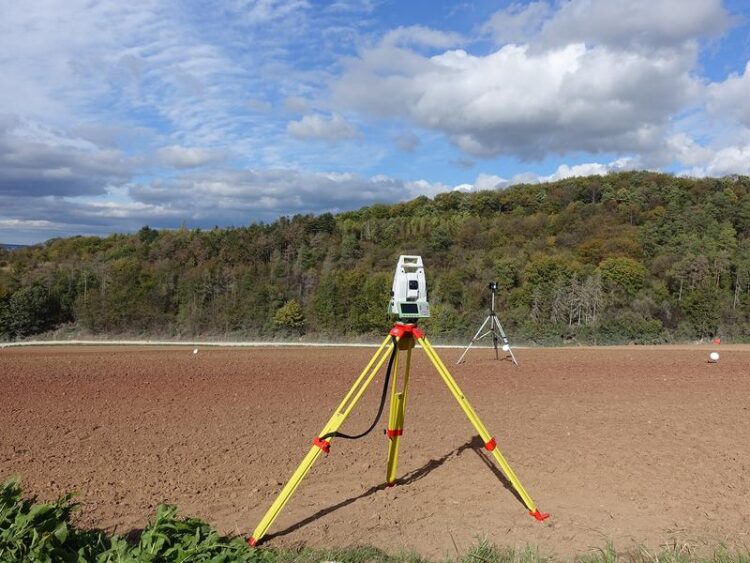Digital crop protection

Digitization of the experimental field, with the measuring equipment in the foreground.
© Fraunhofer IOSB-AST
Digitization in agriculture …
Crop diseases threaten yields in the field. Pests and parasitic weeds cause high crop losses of up to 30 percent every year. In the FarmerSpace project, the Fraunhofer Institute for Optronics, System Technologies and Image Exploitation IOSB in Ilmenau is working together with partners to investigate the use of digital technologies for crop protection. The aim is to detect leaf diseases and the spread of weeds at an early stage and to initiate targeted protective measures using sensors, robotics and data-driven solutions.
Targeted crop protection is critical in agriculture. It ensures that plants are protected from diseases, pests and weeds. A healthy supply of nutrients to wheat, corn and the like influences the quality of the food and prevents crop losses. In the FarmerSpace digital experimental field, the project partners are exploring the potential of digital technologies to detect crop diseases at the right time and place in the field. The platform for practical experiments offers players from research, practice and industry the opportunity to test sensor and data transmission systems, radio sensor networks, optical and machine-supported sensors, drone technology, robotics and machine learning methods in the fight against crop parasites.
The project is being carried out by four partners: the institute branch Applied Systems Technology AST of Fraunhofer IOSB-AST, the Institute for Sugar Beet Research at the University of Göttingen, the Section of Agricultural Engineering at the University of Göttingen and the Lower Saxony Chamber of Agriculture. The German Federal Ministry of Food and Agriculture BMEL is funding the project, which will run from February 2020 to February 2023. The focus is on early detection and control of weeds and leaf diseases in sugar beet and spring wheat, which were sown specifically for research purposes in a trial field near Göttingen. While weed management is the focus in the spring, work in the summer concentrates on leaf diseases.
Digital survey of the field
As a first step, the research team at Fraunhofer IOSB-AST created a 3D model of the field, which serves as a reference model for the project partners. The surface of the five-hectare experimental field was surveyed using a laser scanner and GPS positioning system. This took two days, while the survey using drone technology took only 20 minutes. “However, the time factor alone is not decisive. Primarily, we want to find out which method provides more precise geodata. For this purpose, we also used camera recordings of robots driving over the field. The evaluation of the results, however, is not yet available,” explains André Weiskopf, a scientist at Fraunhofer IOSB-AST. The evaluation is intended to provide information not only on accuracy, but also on practical criteria such as measurement, processing and evaluation time, area capacity and associated costs.
The goal of digitally surveying a field is, on the one hand, to obtain more precise information about the density of the crop stand. On the other hand, it is important to find out when and where a disease infects the crop through viruses, fungi, aphids or other pests, and which measure the farmer can best use to control it. The key, then, is to apply targeted crop protection measures at the right time and limit them locally to the field area where they are needed. This can help reduce the use of crop protection products, thus reducing costs and time. “For example, if the weevil only attacks ten square meters of the entire field, the farmer can disregard the remaining area. In this way, the groundwater is less polluted,” continues Weiskopf. For the Bremen Water Protection Ordinance stipulates that minimum distances must be maintained from flowing bodies of water. Farmers are not allowed to spray pesticides everywhere. “The terrain angle is an important parameter related to this,” explains Norbert Fränzel, a colleague of Weiskopf at Fraunhofer IOSB-AST. “The previous terrain maps do not provide such accurate values in this regard. We hope to obtain more precise data and terrain models by digitizing the field.“
Sensors installed in the field could additionally support making precise predictions regarding pest infestation, detecting changes in time and thus enabling early intervention. Microclimate sensors record soil temperature and soil moisture and provide information on disease infection conditions.
Evaluation of market-available digital solutions for practice-oriented use
Comparing methods for digital terrain modeling provides decision support for farmers when purchasing new technologies and selecting services. Fraunhofer IOSB-AST, for example, is investigating a wide variety of radio technology and radio sensors to determine their suitability for economic use and is flanking the project with its expertise in this field of application. “We derive a recommendation for action as to which technology is suitable for which problem and inform the farmer about the type and number of sensors and measurements required,” says Fränzel.
In addition, machine learning methods create the prerequisite for evaluating the variety of data collected. In a common data room, all field-relevant data is to be recorded synchronously in terms of time and space, so that models can subsequently be trained that provide forecasts for further action required.
Weitere Informationen:
https://www.fraunhofer.de/en/press/research-news/2021/june-2021/digital-crop-pro…
Media Contact
All latest news from the category: Agricultural and Forestry Science
Newest articles

Bringing bio-inspired robots to life
Nebraska researcher Eric Markvicka gets NSF CAREER Award to pursue manufacture of novel materials for soft robotics and stretchable electronics. Engineers are increasingly eager to develop robots that mimic the…

Bella moths use poison to attract mates
Scientists are closer to finding out how. Pyrrolizidine alkaloids are as bitter and toxic as they are hard to pronounce. They’re produced by several different types of plants and are…

AI tool creates ‘synthetic’ images of cells
…for enhanced microscopy analysis. Observing individual cells through microscopes can reveal a range of important cell biological phenomena that frequently play a role in human diseases, but the process of…





















